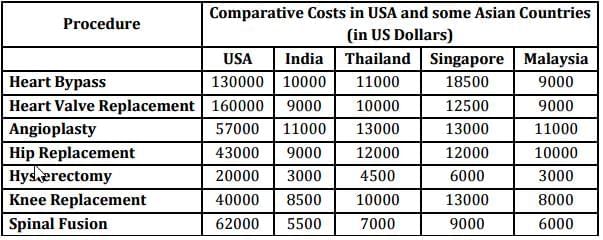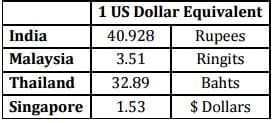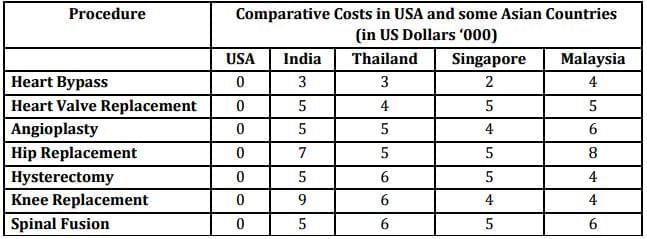Practice Question - 54 (Connected Data Sets) | 100 DILR Questions for CAT Preparation PDF Download
DIRECTIONS for the following four questions:
The Table I shows the comparative costs, in US Dollars, of major surgeries in USA and a select few Asian countries. The equivalent of US Dollar in the local currencies is given in Table II.
The equivalent of US Dollar in the local currencies is given in Table II. A consulting firm found that the quality of the health services were not the same in all the countries above. A poor quality of a surgery may have significant repercussions in future, resulting in more cost in correcting mistakes. The cost of poor quality of surgery is given in Table III.
A consulting firm found that the quality of the health services were not the same in all the countries above. A poor quality of a surgery may have significant repercussions in future, resulting in more cost in correcting mistakes. The cost of poor quality of surgery is given in Table III. Q1: A US citizen is hurt in an accident and requires an angioplasty, hip replacement and a knee replacement. Cost of foreign travel and stay is not a consideration since the government will take care of it. Which country will result in the cheapest package, taking cost of poor quality into account?
Q1: A US citizen is hurt in an accident and requires an angioplasty, hip replacement and a knee replacement. Cost of foreign travel and stay is not a consideration since the government will take care of it. Which country will result in the cheapest package, taking cost of poor quality into account?
(a) India
(b) Thailand
(c) Malaysia
(d) Singapore
(e) USA
 View Answer
View Answer 
Ans: (c)
Total cost incurred by the american citizen in various countries after taking cost of poor quality into account is ( in '000 USD)
America - 57 + 43 + 40 = 140
India - 11 + 9 + 8.5 + 5 + 7 + 9 = 49.5
Thailand - 13 + 12 + 10 + 5 + 5 + 6 = 51
Singapore - 13 + 12 + 13 + 4 + 5 + 4 = 51
Malaysia - 11 + 10 + 8 + 6 + 8 + 4 = 47
Hence the cheapest country is Malaysia.
Q2: Taking the cost of poor quality into account, which country/countries will be the most expensive for knee replacement?
(a) India
(b) Thailand
(c) Malaysia
(d) Singapore
(e) India and Singapore
 View Answer
View Answer 
Ans: (a)
Knee replacement cost in the countries given in the options are :
India - 17.5
Thailand - 16
Malaysia - 17
Singapore - 12.
Hence the costliest treatment is in India.
Q3: Approximately, what difference in amount in Bahts will it make to a Thai citizen if she were to get a hysterectomy done in India instead of in her native country, taking into account the cost of poor quality? It costs 7500 Bahts for oneway travel between Thailand and India.
(a) 23500
(b) 40500
(c) 57500
(d) 67500
(e) 75000
 View Answer
View Answer 
Ans: (d)
Cost of treatment in India in USD ('000) 8 and in Thailand 10.5.
So she pays 2.5 more in Thailand.
Converting in Bahts we get 82500.
Subtracting the total travelling cost of 15000 Baht from the above.
So difference is 67500 Bahts.
Q4: The rupee value increases to Rs.35 for a US Dollar, and all other things including quality, remain the same. What is the approximate difference in cost, in US Dollars, between Singapore and India for a Spinal Fusion, taking this change into account?
(a) 700
(b) 2500
(c) 4500
(d) 8000
(e) No difference
 View Answer
View Answer 
Ans: (b)
Cost for operation in India is around = 5500 * 41.
After Rupee value increases, increased cost in USD = 5500 * 41 / 35 which is around 6500 USD.
Thus the requires difference in price is 9000(for singapore) - 6500 = 2500 USD.
|
102 videos|123 docs|121 tests
|
FAQs on Practice Question - 54 (Connected Data Sets) - 100 DILR Questions for CAT Preparation
| 1. What are connected data sets and how are they used in data analysis? |  |
| 2. What are some common challenges faced when working with connected data sets? |  |
| 3. How can data visualization aid in interpreting connected data sets? |  |
| 4. What methods are commonly used to analyze connected data sets? |  |
| 5. Why is it important to maintain data integrity in connected data sets? |  |















